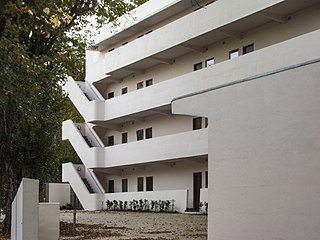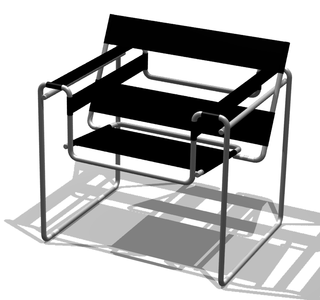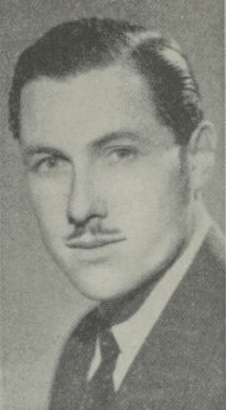
The Aeron chair is an office chair manufactured and sold by American furniture company Herman Miller. Introduced in 1994, it was designed by Don Chadwick and Bill Stumpf and has received numerous accolades for its industrial design. It is featured in the Museum of Modern Art's permanent collection. It has been cited as the best-selling individual office chair in the United States with over 8 million sold.
Hans Jørgensen Wegner was a Danish furniture designer. His work, along with a concerted effort from several of his manufacturers, contributed to the international popularity of mid-century Danish design. His style is often described as Organic Functionality, a modernist school with emphasis on functionality. This school of thought arose primarily in Scandinavian countries with contributions by Poul Henningsen, Alvar Aalto, and Arne Jacobsen.

Isokon Flats, also known as Lawn Road Flats and the Isokon building, on Lawn Road in the Belsize Park district of the London Borough of Camden, is a reinforced-concrete block of 36 flats, designed by Canadian engineer Wells Coates for Molly and Jack Pritchard.

Wells Wintemute Coates OBE was an architect, designer and writer. He was, for most of his life, an expatriate Canadian who is best known for his work in England, the most notable of which is the Modernist block of flats known as the Isokon building in Hampstead, London.

The Wassily Chair, also known as the Model B3 chair, was designed by Marcel Breuer in 1925–1926 while he was the head of the cabinet-making workshop at the Bauhaus, in Dessau, Germany.

Marcel Lajos Breuer was a Hungarian-German modernist architect and furniture designer. He moved to the United States in 1937 and became a naturalized American citizen in 1944.

The London-based Isokon firm was founded in 1929 by the English entrepreneur Jack Pritchard and the Canadian architect Wells Coates to design and construct modernist houses and flats, and furniture and fittings for them. Originally called Wells Coates and Partners, the name was changed in 1931 to Isokon, a name derived from Isometric Unit Construction, bearing an allusion to Russian Constructivism.

George Katsutoshi Nakashima was an American woodworker, architect, and furniture maker who was one of the leading innovators of 20th century furniture design and a father of the American craft movement. In 1983, he accepted the Order of the Sacred Treasure, an honor bestowed by the Emperor of Japan and the Japanese government.

Florence Marguerite Knoll Bassett was an American architect, interior designer, furniture designer, and entrepreneur who has been credited with revolutionizing office design and bringing modernist design to office interiors. Knoll and her husband, Hans Knoll, built Knoll Associates into a leader in the fields of furniture and interior design. She worked to professionalize the field of interior design, fighting against gendered stereotypes of the decorator. She is known for her open office designs, populated with modernist furniture and organized rationally for the needs of office workers. Her modernist aesthetic was known for clean lines and clear geometries that were humanized with textures, organic shapes, and colour.

Artek is a Finnish furniture company. It was founded in December 1935 by architect Alvar Aalto and his wife Aino Aalto, visual arts promoter Maire Gullichsen and art historian Nils-Gustav Hahl. The founders chose a non-Finnish name: the neologism Artek was meant to manifest the desire to combine art and technology. This echoed a main idea of the International Style movement, especially the Bauhaus, to emphasize the technical expertise in production and quality of materials, instead of historical-based, eclectic or frivolous ornamentation.

Modern furniture refers to furniture produced from the late 19th century through the present that is influenced by modernism. Post-World War II ideals of cutting excess, commodification, and practicality of materials in design heavily influenced the aesthetic of the furniture. It was a tremendous departure from all furniture design that had gone before it. There was an opposition to the decorative arts, which included Art Nouveau, Neoclassical, and Victorian styles. Dark or gilded carved wood and richly patterned fabrics gave way to the glittering simplicity and geometry of polished metal. The forms of furniture evolved from visually heavy to visually light. This shift from decorative to minimalist principles of design can be attributed to the introduction of new technology, changes in philosophy, and the influences of the principles of architecture. As Philip Johnson, the founder of the Department of Architecture and Design at the Museum of Modern Art articulates:
"Today industrial design is functionally motivated and follows the same principles as modern architecture: machine-like simplicity, smoothness of surface, avoidance of ornament ... It is perhaps the most fundamental contrast between the two periods of design that in 1900 the Decorative Arts possessed ..."

Knoll is an American company that manufactures office systems, seating, storage systems, tables, desks, textiles, and accessories for the home, office, and higher education. The company is the licensed manufacturer of furniture designed by architects and designers such as Harry Bertoia, Ludwig Mies van der Rohe, Florence Knoll, Frank Gehry, Charles Gwathmey, Maya Lin, Marcel Breuer, Eero Saarinen, and Lella and Massimo Vignelli, under the company's KnollStudio division. Over 40 Knoll designs can be found in the permanent design collection of the Museum of Modern Art in New York City.
John Craven Pritchard was a British furniture entrepreneur, who was very influential between the First and Second World Wars. His work is exhibited in the Victoria and Albert Museum and the Museum of London. He was a member of the Design and Industries Association.

Barber Osgerby is a London-based industrial design studio founded in 1996 by British designers Edward Barber and Jay Osgerby. Historically named variously Barber Osgerby Associates, BOA, Barber & Osgerby and BarberOsgerby, the practice has been called Barber Osgerby since 2008. Barber and Osgerby's work encompasses interiors, furniture, lighting and product design as well as art and architectural-scale projects.

Danish modern is a style of minimalist furniture and housewares from Denmark associated with the Danish design movement. In the 1920s, Kaare Klint embraced the principles of Bauhaus modernism in furniture design, creating clean, pure lines based on an understanding of classical furniture craftsmanship coupled with careful research into materials, proportions, and the requirements of the human body.
The Gane Pavilion, also known as Gane's Pavilion, the Gane Show House and the Bristol Pavilion, was a temporary building designed by the modernist architect and furniture designer Marcel Breuer with F. R. S. Yorke and built in 1936 at Ashton Court near Bristol in England.

Douglas Burrage Snelling (1916–1985) was an Australian architect and furniture designer.

Eisengarn, meaning "iron yarn" in English, is a light-reflecting, strong, waxed-cotton thread. It was invented and manufactured in Germany in the mid-19th century, but is now best known for its use in cloth woven for the tubular-steel chairs designed by Marcel Breuer while he was a teacher at the Bauhaus design school.

The Cesca chair is a chair design created in 1928 by the Hungarian-American architect and designer Marcel Breuer. It consists of a tubular steel frame and a rattan seat and backing. The design was named as a tribute to Breuer’s adopted daughter Francesca. One of the original chairs designed by Breuer is held by the Metropolitan Museum of Art in New York.

Charles William Stendig was an American businessman and philanthropist who was the founder of Stendig, Inc. The company was active between 1955 and 1976 and imported a unique selection of modern European furniture to the United States, focusing on contract-grade pieces suitable for commercial use. Stendig was among the pioneers of the movement that would later become known as mid-century modern.















